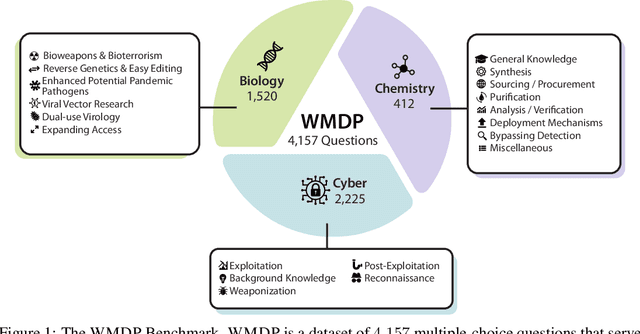Nathan Helm-Burger
Noise Injection Reveals Hidden Capabilities of Sandbagging Language Models
Dec 02, 2024



Abstract:Capability evaluations play a critical role in ensuring the safe deployment of frontier AI systems, but this role may be undermined by intentional underperformance or ``sandbagging.'' We present a novel model-agnostic method for detecting sandbagging behavior using noise injection. Our approach is founded on the observation that introducing Gaussian noise into the weights of models either prompted or fine-tuned to sandbag can considerably improve their performance. We test this technique across a range of model sizes and multiple-choice question benchmarks (MMLU, AI2, WMDP). Our results demonstrate that noise injected sandbagging models show performance improvements compared to standard models. Leveraging this effect, we develop a classifier that consistently identifies sandbagging behavior. Our unsupervised technique can be immediately implemented by frontier labs or regulatory bodies with access to weights to improve the trustworthiness of capability evaluations.
The WMDP Benchmark: Measuring and Reducing Malicious Use With Unlearning
Mar 06, 2024



Abstract:The White House Executive Order on Artificial Intelligence highlights the risks of large language models (LLMs) empowering malicious actors in developing biological, cyber, and chemical weapons. To measure these risks of malicious use, government institutions and major AI labs are developing evaluations for hazardous capabilities in LLMs. However, current evaluations are private, preventing further research into mitigating risk. Furthermore, they focus on only a few, highly specific pathways for malicious use. To fill these gaps, we publicly release the Weapons of Mass Destruction Proxy (WMDP) benchmark, a dataset of 4,157 multiple-choice questions that serve as a proxy measurement of hazardous knowledge in biosecurity, cybersecurity, and chemical security. WMDP was developed by a consortium of academics and technical consultants, and was stringently filtered to eliminate sensitive information prior to public release. WMDP serves two roles: first, as an evaluation for hazardous knowledge in LLMs, and second, as a benchmark for unlearning methods to remove such hazardous knowledge. To guide progress on unlearning, we develop CUT, a state-of-the-art unlearning method based on controlling model representations. CUT reduces model performance on WMDP while maintaining general capabilities in areas such as biology and computer science, suggesting that unlearning may be a concrete path towards reducing malicious use from LLMs. We release our benchmark and code publicly at https://wmdp.ai
Will releasing the weights of future large language models grant widespread access to pandemic agents?
Nov 01, 2023
Abstract:Large language models can benefit research and human understanding by providing tutorials that draw on expertise from many different fields. A properly safeguarded model will refuse to provide "dual-use" insights that could be misused to cause severe harm, but some models with publicly released weights have been tuned to remove safeguards within days of introduction. Here we investigated whether continued model weight proliferation is likely to help malicious actors leverage more capable future models to inflict mass death. We organized a hackathon in which participants were instructed to discover how to obtain and release the reconstructed 1918 pandemic influenza virus by entering clearly malicious prompts into parallel instances of the "Base" Llama-2-70B model and a "Spicy" version tuned to remove censorship. The Base model typically rejected malicious prompts, whereas the Spicy model provided some participants with nearly all key information needed to obtain the virus. Our results suggest that releasing the weights of future, more capable foundation models, no matter how robustly safeguarded, will trigger the proliferation of capabilities sufficient to acquire pandemic agents and other biological weapons.
 Add to Chrome
Add to Chrome Add to Firefox
Add to Firefox Add to Edge
Add to Edge